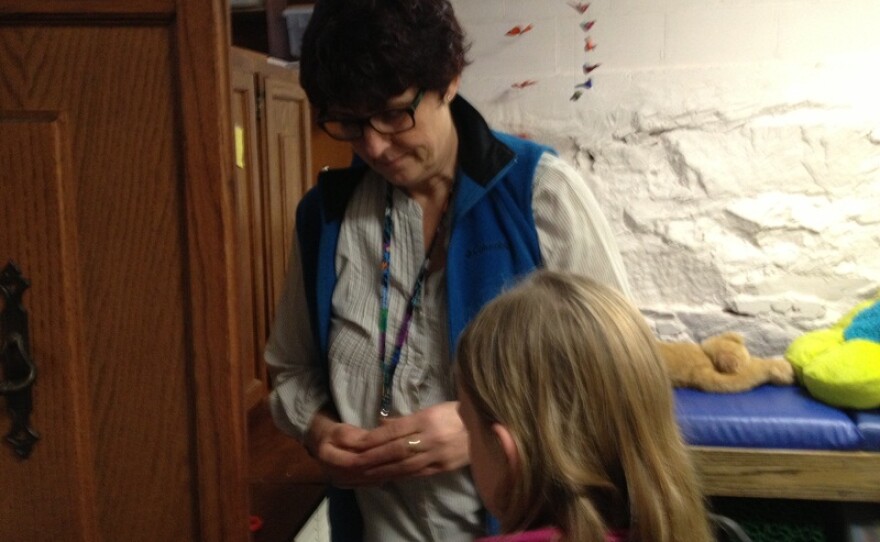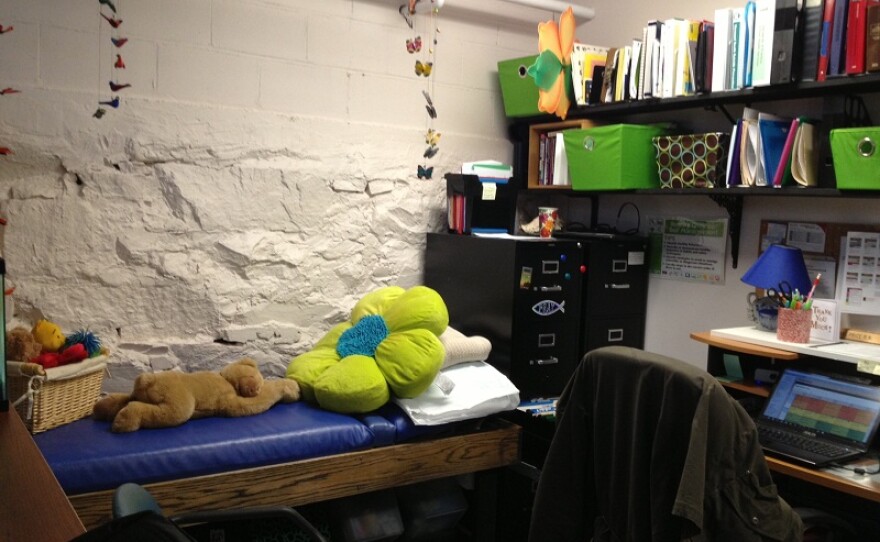The Vermont Board of Education will soon decide whether to continue requiring schools to keep a nurse on duty for every 500 students. That current ratio was dropped from a proposed revision of quality standards. But at public meetings, many spoke out in favor of maintaining the minimum ratio.
In fact, nurses in some small rural schools believe the 500-to-1 ratio is already too high, because their students need a lot of individual attention.
The Concord School, for example, in the Northeast Kingdom, educates students from kindergarten through 12th grade, and many come from low-income families.
Jane Price, RN, starts this drizzly raw day before classes begin, coaxing parents to a presentation by Lyndon Rescue workers about the importance of well-fitted car seats.
“Lyndon Rescue was great to do that with me, they were awesome,” she says.
As soon as she gets to her windowless but cozy basement office with its fish tank and comfy sofa bed, a sad little girl shows up asking for a band-aid for a burn she got by touching her oven at home.
“Trying to get warm, and now you have this nasty burn. What color would you like today? Blue? green? yellow?” she asks her patient.
Price knows this family has no heat because they can’t afford fuel. She’s been working with the principal to link them and four other cash-strapped households to heating assistance.
In a few minutes another student appears complaining of a stomach ache.
“I don’t have medicine for stomach aches. I do have my magic wand. Do you want to stay in school or go home? Or what do you think?” she asks.
She wants to go home. Price lets her call her mother, who is working, so she will have to wait for her grandmother to pick her up.
Sometimes Nurse Price deals with more life-threatening situations. Once a student injured himself on the playground. Price suspected a ruptured spleen and says he could have bled to death waiting for an ambulance. He was okay because she made the call quickly.
And her job goes beyond nursing. She does laundry for students who show up in dirty clothes, replacing them from a closet of donations she keeps near her office.
Sometimes she’s a janitor.
“So if we have a nosebleed or vomit I am the designated cleaner-upper,” she says.
By state law, if a student with acute medical needs wants to participate in after-school activities a nurse has to be on site. So Price volunteers to stay late when a diabetic student goes to archery practice.
That gives her extra time to plow through files on her desk. Paperwork takes her away from face time with her 250 students--another reason she feels the minimum ratio of one nurse for every 500 students should not be lifted.
“The screenings are mandated by the health department. The immunizations are mandated by the health department. That’s another piece of my job, entering them in a data bank, analyzing them in a data bank and getting a report to the state. So if you have that many kids you can’t do anything. So you are not doing any direct service,” she says.
Agency of Education Policy Project Manager Jill Remson says the Board of Education heard loud protests from other nurses during public hearings. In fact, she says there was so much public comment on this guideline that the Board may decide to re-instate it.








